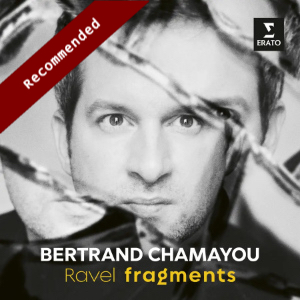
Ravel Fragments
Bertrand Chamayou (piano)
rec. 2024, Miravel, Correns, France
Erato 2173260123 [61]
Bertrand Chamayou’s recording of the complete Ravel Solo Piano Music was released in 2016. Conscious of the 150th anniversary of the composer’s birth this year, he’s given considerable thought to what a fitting tribute might be without revisiting that core repertoire. By ‘considerable’ I intend no exaggeration. This is an imaginative, beautifully calibrated album where Ravel’s own music is incandescent with the warmth generated by pieces from other composers Chamayou has chosen.
Structurally the spine of the album is made up of Ravel transcriptions. The three Fragments symphoniques he made from Daphnis et Chloé, and two others made by Chamayou. These are surrounded by pieces which have a connection to Ravel and often specifically to the piano music. At the recital’s centre is Ravel’s transcription of La Valse. The whole works brilliantly.
The Daphnis fragments are relatively rarely performed but one look at the score reveals the care which Ravel took in realising them for the piano. He retains the essence of the orchestral version with quite restrained use of harmonic and technical possibilities and precise performance directions. It looks if not exactly simple, then at least understandable. Listening to Chamayou’s evocative playing however I experienced constant surprise and wonder that the notes on the page had somehow manifested such colours. It’s alchemical musicianship. Chamayou’s own transcriptions are entirely worthy to sit alongside Ravel’s. He retains the sparkling ingenuousness of the Chanson de la mariée from 5 Mélodies populaires grecques with grace and simplicity and his version of the Piece en forme de habanera is joyous fun.
The non-Ravel pieces are a perfect complement. All, as Chamayou writes, evoke Ravel. From Joaquin Nin’s Mensaje a Ravel whose Spanish inflexions are interestingly different to Ravel’s Habanera, to the Menuet spectral (à la mémoire de Maurice Ravel) of Ricardo Viñes, whose three time steps have a hesitancy that at each stutter bring what feels like a half remembered echo of passages from Le Tombeau de Couperin particularly. More direct references to the piano music can be found in Frédéric Durieux’s menacing Pour tous ceux qui tombent which quotes from Le Gibet from Gaspard de la Nuit and the inventive, occasionally startling, Signets by Betsy Jolas which is predicated on a series of motifs from Gaspard. Salvatore Sciarrino uses the same set of pieces in a different way in his shimmering De la nuit, utilising and developing scraps of melody from Scarbo and Ondine in a fascinating and ingenious collage.
Everything on the album builds up to or fades away from Chamayou’s extraordinary performance of La Valse however. Ravel wrote a brilliant transcription of his orchestral score for two pianos, which is well known and frequently performed. At the same time, he also produced a version for solo piano. It looks as if it was primarily intended for use by a répétiteur for rehearsals of the ballet. The two staves provide a framework which would certainly orient dancers learning steps. But then fascinatingly Ravel at various junctures adds a third stave which sometimes represents a passage by a solo woodwind instrument or the harp but at others additional rhythmic or harmonic detail added by, for example, the cello section. There is no guidance as to how the pianist is expected to execute this. As Chamayou says in his booklet notes it’s as if Ravel is saying to the pianist ‘handle it!’. Perhaps given his own limitations as a pianist Ravel tacitly wanted to acknowledge there were others with greater technical accomplishment who could do more. Anyway, Chamayou is being modest and understated when he describes the contents of the third stave as ’embellishments’. Who is to say when dealing with this most liminal of composers what is ornamental and what fundamental, especially if one is to make a concert version of the score? Chamayou’s response is little short of miraculous, where he seems to realise all of it, including at times what look like physically unplayable passages, without apparently losing anything. It sounds dazzling and virtuosic, and those orchestral timbres are thrillingly animated. Here, as with the album as a whole, the piano sound of Chamayou’s Steinway Model D has also been exquisitely captured by the Erato engineers.
This is a fabulous recital then, providing more evidence that an enhanced appreciation of Ravel’s music is often achieved when he is placed alongside others. Chamayou’s notes have an admirable clarity and directness, slightly refracted in the booklet’s English translation.
Dominic Hartley
Previous review: Philip Harrison (April 2025)
Buying this recording via a link below generates revenue for MWI, which helps the site remain free


Contents
Maurice Ravel(1875-1937)
Trois Beaux Oiseaux du paradis*
Danse légère et gracieuse de Daphnis**
Chanson de la mariée (from 5 Mélodies populaires grecques)*
Fragments symphoniques de Daphnis et Chloé : Nocturne – Interlude – Danse guerrière**
Pièce en forme de habanera*
La Valse**
Scène de Daphnis et Chloé**
* Transcribed Chamayou
** Transcribed Ravel
Joaquín Nin(1879-1949)
Mensaje a Ravel (from Cadena de valses)
Salvatore Sciarrino(b.1947)
De la nuit
Alexandre Tansman(1897-1986)
Prélude No.5 (Hommage à Maurice Ravel)
Frédéric Durieux(b.1959)
Pour tous ceux qui tombent (Hommage à Maurice Ravel)
Ricardo Viñes(1875-1943)
Menuet spectral (à la mémoire de Maurice Ravel)
Xavier Montsalvatge(1912-2002)
Elegía a Maurice Ravel
Betsy Jolas(b.1926)
Signets (Hommage à Ravel)
Arthur Honegger(1892-1955)
Hommage à Ravel (from 3 Pièces)

















